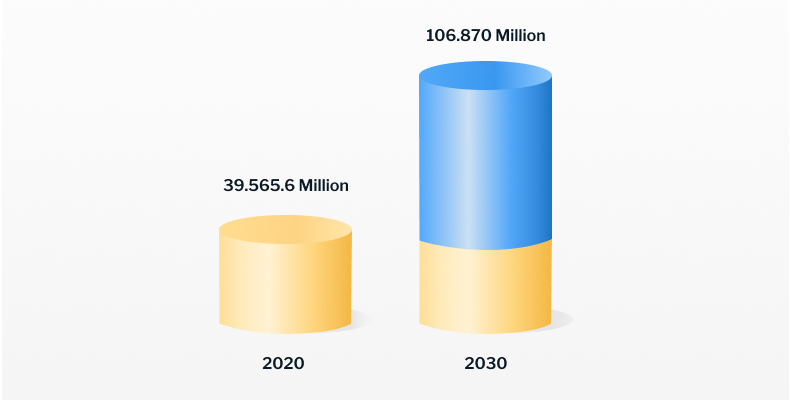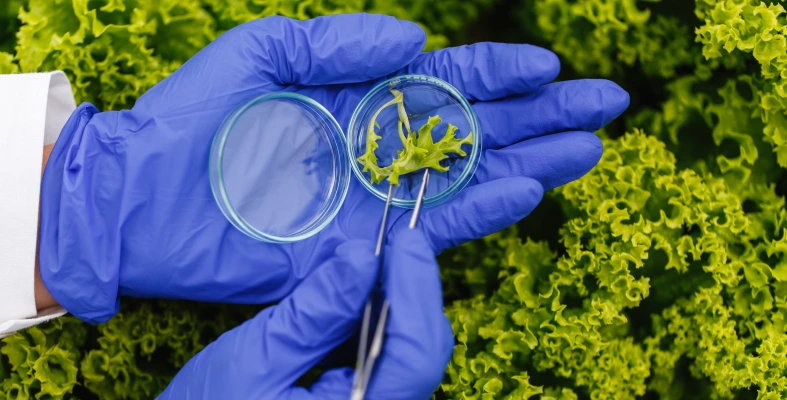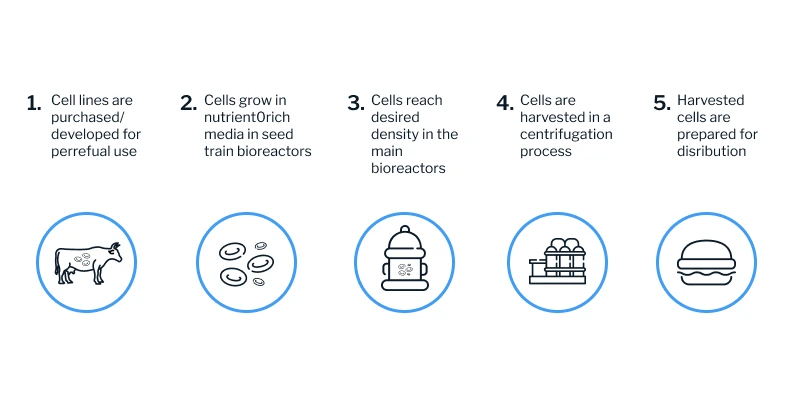We use cookies to ensure we give you the best experience on our website. By clicking Agree you accept our Privacy and Cookies Policy.
An overview of agricultural biotechnology in 2026

 12 minutes read
12 minutes read
Content
Green biotechnology is ancient. For many centuries, people have selected animals and plants with the best traits to achieve the desired result and used biological processes like fermentation. The demand for food has always been strong. Now it’s enormous and drives the growth of the world’s AgriTech market, especially in the most-populated Asia-Pasific region. Besides, extensive farming has led to low availability of farmlands, putting enormous pressure on farmers to exploit what they already have to the maximum. The challenge is huge – to feed the global population, which will reach 11.2 billion by 2100, according to the United Nations. At the same time, the methods of boosting yields must be ethical and not aggravate the damage we are already inflicting on the planet. Modern biotechnology, armed with efficient tools of genetic engineering, applied immunology, genomics, and as well as such information technologies as Big Data, Machine Learning and Artificial intelligence, promises to find solutions to some of humanity’s burning issues.
State-of-the-art software solutions underpin the success of any biotech-related business from smart cattle breeding to vaccine production.
Agri-Biotech: An engineering discipline powered by data and code
From a software developer’s viewpoint, modern agricultural biotechnology is fundamentally an engineering challenge – but instead of silicon and circuits, we’re engineering biological systems. And like any complex modern engineering field, it’s increasingly reliant on massive datasets, sophisticated algorithms, and robust software systems. This isn’t just farming anymore; it’s high-tech bio-engineering scaled for global impact.
The scale of this field is immense, reflected in its significant market size globally – a clear indicator of the investment and technological infrastructure being built around it. This growth is fueled by the urgent need to feed a growing planet while facing environmental constraints. Our code, our data pipelines, and our analytical tools are becoming as crucial as the beakers and petri dishes in the lab.
The digital foundation: Bioinformatics, AI, and Big Data in the field
The mention of Information Technologies like Big Data, Machine Learning, and AI in agricultural biotech is particularly exciting from a software perspective. These aren’t just buzzwords here; they are the engines driving discovery, analysis, and application.
- Bioinformatics: This is where biology meets computation head-on. Analyzing genomic sequences, predicting gene functions, understanding protein structures – these tasks generate petabytes of data that require specialized algorithms and software tools developed by bioinformaticians. Think of it as the “IDE” for genetic engineers.
- AI for trait prediction: Machine learning models are trained on vast datasets of genetic information, environmental factors, and crop performance to predict which gene combinations are likely to result in desired traits like drought resistance or higher yield. This significantly accelerates the breeding process, moving from years of field trials to data-driven predictions.
- Big data from the farm: Modern farms are becoming data hubs, with sensors collecting information on soil conditions, weather, pest presence, and crop health. Integrating this data with genetic information allows for precision agriculture, enabling targeted application of biotech solutions exactly where and when they are needed. Our software systems are needed to collect, process, analyze, and visualize this complex, spatio-temporal data.
- Simulation and modeling: Before modifying a gene or releasing a new biological agent, developers and scientists use complex simulations to model potential outcomes, assess risks, and optimize designs in a virtual environment.
Essentially, software development provides the platform, the tools, and the analytical power that allows agricultural biotechnologists to understand, manipulate, and optimize biological systems at an unprecedented scale.
Global agricultural biotechnology market revenue forecast

Source: www.researchandmarkets.com
According to McKinsey Global Institute, “Bio Revolution”- biomolecules, biosystems, bio machines, and biocomputing will constitute about 60 percent of the physical global economy. Let’s look at some instances of this truly transformational influence of technological advances in the agricultural sphere.
Engineering genes for a better harvest: Code-assisted biology
Techniques like genetic engineering and gene editing (CRISPR-Cas9) are powerful, but their application relies heavily on computational design and analysis.
- Designing the RNA sequences used in CRISPR, identifying target genes, and verifying the success of genetic modifications all involve sophisticated software tools and genomic databases.
- Consider examples like Bt cotton. From a developer’s view, this is an engineered system where a specific genetic “module” (the Bt gene) is integrated into the cotton plant’s “code” to provide a built-in pest resistance “feature.” Developing this involved understanding the pest’s biology, identifying the right gene, and using molecular tools (guided by bioinformatics) to perform the genetic “insertion.”
- Golden Rice, engineered to produce beta-carotene, is another example of using genetic engineering to add a vital nutritional “functionality” that was missing in the original organism.
These aren’t just random biological occurrences; they are the result of deliberate, data-informed engineering efforts.
Sustainable solutions, traceable by design
Agricultural biotechnology offers powerful tools for sustainability, and software is key to implementing them effectively and transparently.
- Crops engineered for pest resistance reduce the need for chemical sprays – a clear environmental benefit. Software systems in precision agriculture can further optimize the minimal use of other inputs.
- Developing crops that are more water-efficient or resilient to harsh climates directly addresses the challenges of climate change, and simulation software helps predict how these traits will perform in different environments.
- The need for transparency and traceability in the food chain, especially with biotech products, requires robust data management and blockchain-like solutions to track products from farm to fork.
Navigating the ethical code and regulatory frameworks
As with any powerful technology, agricultural biotechnology comes with challenges and requires careful consideration of ethical implications and robust regulatory frameworks. From a software development perspective, this translates into the need for:
- Responsible AI and data usage: Ensuring fairness, preventing bias in algorithms used for breeding or resource allocation, and maintaining data privacy in large agricultural datasets.
- Traceability and transparency systems: Building secure and accessible platforms to inform consumers and regulators about biotech products.
- Compliance software: Developing systems that help researchers and companies navigate complex and varying international regulations regarding GMOs and other biotech applications.
Addressing concerns about safety, environmental impact, and ethics requires not just scientific rigor but also transparent communication and systems built on trust and verifiable data.
The future is integrated: Biotech, AI, and automation
The future of agricultural biotechnology is exciting because it lies at the intersection of multiple rapidly advancing tech fields. We’ll likely see:
- Increased integration of AI and machine learning for predictive analysis in breeding, disease detection, and yield optimization.
- The rise of robotic systems and automation in fields, guided by AI and utilizing biotech crops designed for mechanical harvesting.
- More sophisticated simulation environments for designing and testing complex genetic modifications and entire agro-ecosystems.
- The use of blockchain for enhanced traceability and supply chain management of biotech products.
For software developers, this means new challenges and opportunities in building the platforms, analytical tools, and automation systems that will power the next generation of agricultural innovation. The line between “biology” and “technology” is blurring, and code is a universal language bridging the gap.
Big data and artificial intelligence
Big Data is invaluable technology for any research as it gives sense to vast volumes of information. How data is stored and analyzed is critical for most scientific endeavors. For instance, the global scale Genome Project, took 13 years and cost billions of dollars. Modern Big Data libraries reduce the cost of human or animal genome-related projects to just thousands of dollars. AI-based analysis – interpretation and obtaining insights from datasets, and visualization – presenting them as dashboards and charts can shorten the time to market for new discoveries. Latest big data trends – cloud migration, edge computing, augmented analytics – make previously impossible projects a reality.
Bioimaging
This non-invasive technology allows visualizing molecular, cellular, and metabolic processes in living organisms over a specific period. It became possible thanks to the breakthrough – super-resolution and cryo-electron microscopy and the development of digital imaging. Bioimaging allows distinguishing between healthy and disease-affected cells, which is critical for effective diagnosis and therapy. In addition, it plays an essential role in creating crops with higher climate resistance and yield. Bioimages are big data. Further advances in this promising field require close cooperation of bioinformaticians, computer scientists, and biologists. In the future, technology will become more portable with even smaller sensors and create new possibilities for in situ imaging of animals and plants.
Genetic manipulations
Traditional plant and animal breeding methods are extremely time-consuming. Genetic engineering allows making rapid changes and the future belongs to it, despite constant public debates about its safety and long-term implications. For instance, in 2014, according to the Plos One Journal, thanks to genetic modifications, the use of chemical pesticides fell by 37%, crop productivity and farmer profits rose by 22% and 68% respectively.
Since corn was first genetically modified in 1994, and Dolly the sheep cloned in 1996, many things have changed. Now scientists can create virtually anything. However, obtaining government approval still takes a very long time. A vivid example of this is the AquaBounty company that specializes in growing bioengineered Atlantic salmon. The organism was first designed in 1989, but only in 2020 did they get the first harvest at the Indiana farm.
Animal biotech focuses on two areas: breeding for meat or milk and growing animals with biomedically valuable proteins in their blood or milk.
Crop farming biotech helps to boost yields in a way that is safe to the environment. Plants with such agronomic traits as insect and disease resistance, herbicide and temperature tolerance, and altered nutritional content can be life- transforming. For example, the Banana 21 project aims to solve the problem of nutritional deficiencies in Uganda through genetically modified bananas, enriched with iron and pro-vitamin A.
Research laboratories rely on a number of advanced methods, among them:
- Genome editing will generate the highest revenues in the AgriTech market in the foreseeable future. DNA modifications are made directly inside the cell using the enzyme system.
- Mutagenesis – scientists use radioactivity or chemicals to trigger random mutations, which may be the desired trait.
- Polyploidy is modifying the quantity of chromosomes in crops with chemicals.
- Protoplast fusion involves cross-species merging of cells or their components to transfer specific traits.
- RNA interference is suppressing certain genes in a cell.
- Transgenics is the introduction of new foreign genes in an organism to obtain desired characteristics.
Floriculture
Gene manipulations produce flowers and ornamental plants colors and scents that never existed before. It opens a lot of commercial opportunities for floristry. Agrobacterium-mediated transformation is one of the methods used in floriculture: the Agrobacterium tumefaciens pathogen transfers foreign genes into host organisms.

Micropropagation or tissue culture
In simple words, it is plant cloning. This technology is used to produce a large volume of genetically identical plants from a tiny piece of plant tissue. As there is no need for seeds or pollinators, it is especially helpful for endangered species conservation.
Disease management
Diseases in agriculture cause millions of dollars in losses. The tools of biotechnology are used to produce nutritional supplements and vaccines for animals that boost their disease resistance.
The Sterile Insect Techniques (STI) do not involve genetic modification of pests which spread diseases and spoil crops. It uses irradiation for mass rearing of sterilized insects. This environmentally benign method has proven high efficiency in decreasing crop and livestock losses.
Biotechnology is also very helpful with antibiotic development through microbial fermentation.
Biofertilizers
Bio-fertilizers are eco-friendly substances that improve soil fertility and stimulate plant nutrition. Plant growth-promoting microorganisms in them (PGPM), for instance, blue-green algae, help plants absorb nitrogen and water from soil and synthesize amino acids and proteins. They are also capable of partially protecting plants from droughts and insect pests and improving their resistance to certain soil-borne diseases. Although bio- fertilizers have some flaws, like limited shelf life and temperature sensitivity, which can be eliminated thanks to new technologies, they are an important constituent part of sustainable farming.
Cultivated meat
McKinsey Institute predicts that lab-grown meat could constitute 0,5 % of the world’s meat supply and become a $25 billion industry. How does it work? Scientists take animal cells and grow meat products with defined characteristics in a controlled environment. Although academic scientists started experimentation a decade ago, cultivated chicken was first served to guests in 2020, at a club in Singapore – the only country where such products are officially approved. As of 2021, there are almost 100 startups in the industry that have attracted $ 600 million investments so far. It remains questionable whether” slaughter-free “meat will win consumers globally – it is not easy to overcome people’s fear of novelty. Another obstacle is high manufacturing costs. However, it might become commercially viable by 2030.
Production process for cultivated meat

Source: McKinsey
The ambitious BlueNalu company specializes in cell-cultured seafood. In a n interview for Forbes, Lauran Madden Ph.D., a tissue engineering expert and lead scientist of the company, explains why this technology is safe and forward-thinking.
Conclusion
The development of the biotechnology industry is mind-blowing. It is not only about business, but also a mission. Many new fascinating discoveries are underway, in the R&D stage, e.g., the usage of genetically modified protein-rich crops in the pharmaceutical industry. Blackthorn Vision has cooperated with biotech industry leaders to design software that helps both scientists and farmers reach their goals, better understand their work, automate and optimize all processes. Let’s partner up to accelerate your project!







































































